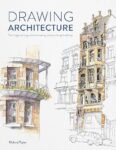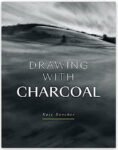It's been a busy day as I've been making notes on this book that I…

The Art Of The Line In Drawing, Frédéric Forest – Book Review
This book has been sitting around near the bottom of my wishlist for a while. I kept thinking of it as a luxury book: something that I probably didn’t need but that nevertheless might be interesting or inspiring and that would make an interesting birthday present. But then the price dropped a lot over the last few days and I decided to treat myself and buy a copy. What harm can it do?
The book, as you’ve probably guessed, is about a certain style of painting. I’d call it minimalist drawing. It’s like drawing but (i) you don’t colour in the shapes, and (ii) you’d probably have trouble colouring in the shapes anyway because not every edge goes down on paper – only enough edges to tell the story.
The book is a 128 page paperback, so thinish. Chapter–wise we have
– 23 pages of introduction and buildup
– 8 pages pages on materials
– 12 pages on where to find inspiration
– 78 pages of demonstrations
– 7 pages of closing and index
I said that the book was thinnish. I’m going to change that and say that it’s thin. Each of the four chapters starts with a double page spread with nothing but the chapter name – not even photos of paintings. Fred must have been struggling to fill the book. I also found the introductory and inspiration chapters to be a bit empty of content. So, really, we’re looking at, what, a 82 page book? 8 plus 78 less 4 blank pages.
The six pages on materials are very useful, with lots of alternative suggestions and opinions. That gets a tick.
And then the meat of the book is the 76 pages of demonstrations. Fred takes us through loads of different subjects including landscapes, portraits, animals, figures, hands and legs. Plenty of variety. For each subject, he goes through two demonstrations of line paintings in different styles and shows us two more finished paintings. So that’s four paintings, two of which we see step by step. The demos are demos and not instructions, which I like, but I find them disappointingly short of explanations of why he took different approaches. There are a few tips in there too, but not many. There’s no coaching on how to observe or how to do contour drawing. If I learn anything from these demos it’s in the order in which Fred puts the lines down and in when he chooses to stop. So while there are few tips, there’s something to be learned from just watching how Fred works.
So it’s a thin book and one that I didn’t learn much from but that may well act as a source of inspiration for future paintings on days when I don’t have the time to put together the Full Monty. It’s not one of those books that annoys me with lazy writing. It’s more what I’d call minimalist writing which, of course, matches the style of artwork in the book and messes with the brain a little, turning me into a minimalist thinker while I read it. Maybe that was the idea?
Overall, compared to other books that are all about inspiration such as those by David Bellamy or Bill Buchman, this feels like a step down. Not just in terms of thickness and scope but also (as expected, to be fair) artistic quality. This is a luxury book, not something that everybody should be heading out to buy. It looks good on the shelf but I’m not sure I’d replace it if my studio burnt down. And that means it scores two palettes.
🎨🎨








Leave a Reply